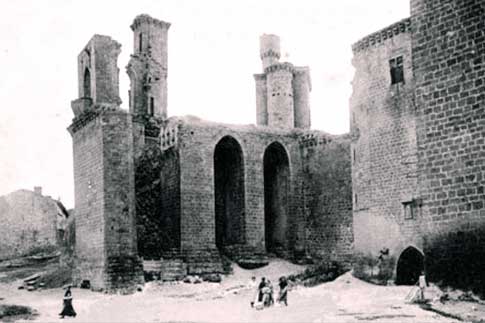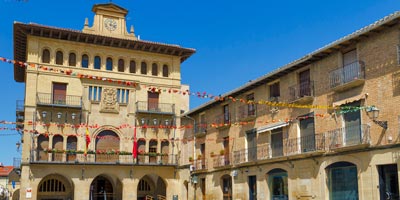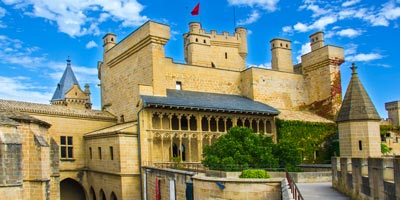Olite holds one of the greatest heritage treasures of Navarre within its walls. It is the palace that King Charles III started to build during the 14th century as his main residence.

Olite holds one of the greatest heritage treasures of Navarre within its walls. It is the palace that King Charles III started to build during the 14th century as his main residence.
There is a lot you can do in Olite, a medieval town whose historic, monumental attractions add to its renown based in wine (you can visit its Museo del Vino and its many other wineries). If you have binoculars at hand and an interest in birds, you can head down the N-5332 highway to Pitillas to visit the Laguna de Pitillas Park. Those that have more time and are willing to go a little further can visit the Bardenas Reales Park, a great area for active tourism. You can also make a day trip to the west from Olite, beginning with a quick visit to nearby Tafalla, then spend at least half a day in the walled city of Artajona; you also can’t miss its surrounding Roman city of Andelos and the dolmen of Farangortzea.
You can read all about the delightful cuisine and places to stay in the area in our pages for eating and staying in Olite.
The area has been inhabited since the time of the Roman Empire (1st century AD), which is when its walls were built. In 621, it was refounded by Gothic king Suintila, who gave the town the name Ologite and fortified it to protect it from the Basques.
It received its first jurisdiction in 1147, similar to that of Estella, at the hands of king García Ramirez the Restorer, thus attracting more people to join its population. The progression accelerated in 1266 with the receipt of the privilege of hosting a fair that lasted for 15 days.
On April 18th, 1407, the Merindad of Olite was created, leaving Navarre divided into five autonomous administrative units. The capital of Olite was promoted by king Charles III the Noble, who exercised over the village a special protection. This monarch became so fond of the village that he ended up building an immense and luxurious palace in the town to serve as a residence for him and his wife, the sophisticated Leonor de Trastámara. However, this would bring disillusionment for the king: “In the kingdom of Navarra I was neither welcomed nor treated as I should have been,” he came to affirm.
The king spent much of his time ruling in this palace. There, on November 6th, 1419, he signed the Tratado de Olite, protecting the independence of the kingdom by preserving the peace with Castilla. The king died in this palace only 6 years later.

The majority of the population, throughout the history of Olite, belonged to the Agramontés, the old nobility loyal to the Albret kings. But when the Invasion of Navarra occurred in 1512, Olite surrendered without a fight. In 1516, the invasion of the army of the kings of Albret, supported by the French, the population was pronounced in favor of its former kings. Soon after, it surrendered to the Navarran Beaumonteses and their Castillian and Basque allies.
In 1630, Philip IV granted Olite the title of the city. The following centuries were ages of depression and depopulation for the town, which ended up falling into an abandon. This was made worse by the gradual disappearance of the power of the Merindades from the mid-19th century. In 1885, Olite suffered a serious Cholera epidemic that decimated most of its population. To celebrate the people that survived, the Fiesta de la Virgen del Cólera is celebrated every year.
During the Spanish Independence War, in 1813, the Royal Palace of Olite was set on fire by the guerillas Espozo and Mina to keep the French troops from taking it. Later restoration has managed to restore it to its original appearance and make it the big tourist attraction that it is today.
The main heritage and tourist attraction in Olite is its Royal Palace. It is undoubtedly the most important civil Gothic building of Navarra, of which it used to be said that it had “as many rooms as days in the year.” Its disorderly appearance is the result of many additions and a lot of remodeling. At the time of its construction, it was equated to the most sumptuous palaces of the continent.
A visit to its dependencies can be separated into two parts: the Old Palace, the ancient Roman and Visigothic fortress, which has been converted into tourist inn; and the New Palace, which corresponds to the extensions made by Carlos III. The masonry of Martín Pérez de Estella, the carpentry of the Tudelano Moor Lope “The Barbicano,” and the carvings by Jehan Lome de Tournay stand out the most.
The Church of San Pedro, a Romanesque building renovated in the Baroque style, is distinguished by its tall, octagonal, Gothic tower with a square floor plan and topped by a slender, pointed arrow. The other parish of the city, the Church of Santa María la Real, was built in the 15th century with a richly decorated door and a main altarpiece by the painter Pedro de Aponte. According to legend, the Convent of San Francisco de Olite was founded by the same San Francisco de Asís in the 13th century during his pilgrimage to Santiago de Compostela.

Something else that is very interesting to see in Olite is the best and largest walled enclosure of Roman origin in Navarra, with a perimeter measuring 600 meters and the remains of 12 of its old towers in its layout. Another of the patrimonial emblems of the city is the Torre del Chapitel, which forms part of the Medieval Romanesque walls. Throughout its history, it has exercised the functions of the Casa del Mercado y Cámara del Concejo (House of the Market and Chamber of the Council). Also, it was one of the first public clocks in the Iberian Peninsula. Take note of the pointed-arch passageway at its feet.
Olite is the wine capital of Navarra. Its tradition of cultivating wine dates back to the Roman era, and it knew many successive golden ages during the residence of Charles III and during the Phylloxera plague that devastated the French vineyards.
During the 20th century, it was the forerunner of the Navarran Wine cooperative movement. In its territory, you’ll find the biggest concentration of wineries with Navarran D.O.s, like Cosecheros Reunidos, Marco Real, Pagos de Araiz, Piedemonte, Ochoa, Señor de Andión and Vega del Castillo. To learn more about the history of wine in Navarra, you only have to visit the Museo de Vino de Navarra in Olite.


42° 29′ 15″ N, 1° 39′ 45″ W
42 km to Pamplona, 84 km to Logroño, 371 km to Madrid
Parkings at Ronda del Castillo and Paseo de Doña Leonor
388 m
3,875 (2013)
Santa Brígida (May 22nd), Virgen del Cólera (August 26th), local festivals (13-19 of September)
Medieval market (August), Wine Harvest Festivals (last weekend of August-first weekend of September)
Papier maché crafts from El Txoko
Pacharán of Destilería la Navarra